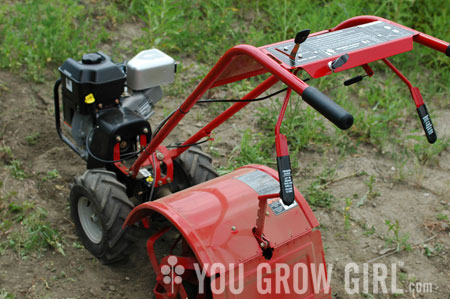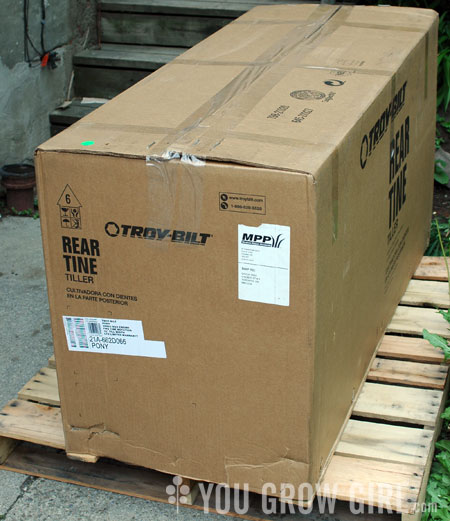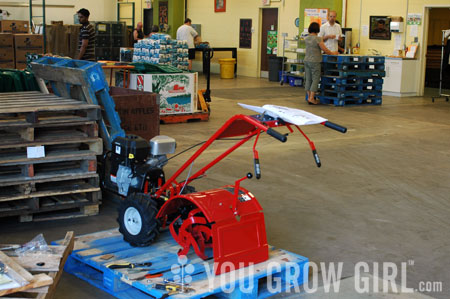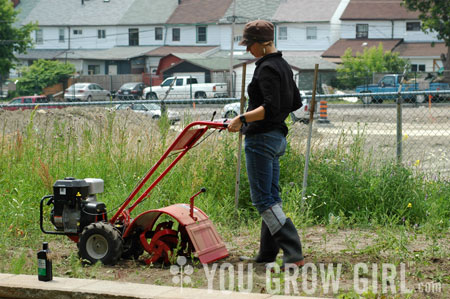
When Troy-Bilt, makers of large lawn and garden power machines, contacted me about reviewing a product I was a little hesitant. Actually I was a lot hesitant. I said no at first and then mulled it over for about a month before deciding to give it a try. First, let me explain.
My first few experiences in creating an in-ground garden involved a lot of digging. Having nothing else available, I grabbed a large shovel and I dug. And I dug and dug and dug. Anyone who has ever used their own two hands to dig up a bed knows what back-breaking work it can be. Not a whole lot of fun. Over time, the more I learned about gardening the more I realized that all that digging might have been a little unnecessary, especially for a small-scale gardener such as myself; harmful even. Here’s why:
Tilling, digging, and double-digging disrupts the soil. And soil is complicated really, much more complicated then we give it credit for. The soil is alive (yes even the crappy stuff) with all sorts of important organisms and minerals. A relationship exists between the elements that live and thrive within the layers that sit between the soil surface and the ones below. When we dig, we shake those layers all over the place, messing things up good. We also bring weed seeds up to the surface giving them ample opportunity to germinate and subsequently drive us nuts.
I’ve given up digging in the last few years. I dig holes when I need to put in plants. But for the most part I have decided to leave the soil be, adding compost and amenders to the surface with a little “scratching” but no additional digging required. I still can’t say whether or not double digging would have made things worse but I can see that NOT digging has been positive for both the garden and me. I am certainly glad to have that painful nonsense behind me.
So why did I decide to try out a tiller? For a couple of reasons, the first being that the no-dig no-till method is one theoretical approach to gardening but certainly not the only one out there. It’s the one I have chosen for me, but I’m not about to stick my nose up at the diggers of the world or stuff the no-till method down everyone’s throats as the tried and true way forsaking all others. The End. While I do not have any use for a tiller and have no plans to use one in my personal gardening experience anytime soon, if ever, I figured it would be worth it to at least see what all the fuss is about. I have absolutely no prior experience with a tiller. I have never seen nor touched a tiller either in use or stationery. I also realize that my no-till policy is a little biased. It’s easy to shun the use of a large machine when you’re gardening in a small space or have lots of people-powered help to get a garden going.
Beyond the soil my other concern about using a tiller is in the environmental impact associated with adding a gas-powered machine to the gardening process. What has always been human-powered labour in my experience would be easily replaced with a machine. But that ease comes with an economic and environmental price. Since they aren’t making solar-powered tillers (as far as I know) the “greenest” option was an electric machine. Troy-Bilt makes an electric cultivator but it is not meant for digging compacted ground and it isn’t even really a plausible option in an urban environment where a power source is rarely available. I knew I would be testing this machine in a public park or site without electricity or a plug-in point. We had to go with gas powered. I expressed these concerns to Michelle at Troy-Bilt who looked into sending me the most efficient model they had, a 4-cycle machine called the Pony Rear-Tine Rototiller.
And so the tiller arrived on my doorstep one afternoon. Or more accurately, a 200 lb machine set on a skid that I was not prepared for was set down on the sidewalk in front of my building one afternoon. Here’s what it looked like:

I don’t have a garage and I live in a neighbourhood where things that are not bolted down disappear, possibly even 200 lb machines. Since I obviously have no need for, or space to house a 200 lb machine I had decided to donate the tiller to Food Share. Food Share is an organization dedicated to helping make good food accessible throughout the City of Toronto. They are also the home of the Toronto Community Garden Network, helping people get community gardens started in the city. I figured if any urban organization could actually use a tiller they’d be it. Turns out they didn’t have one. Thankfully they were able to dispatch a crew to pick up the machine and the crisis was averted.
Next came putting the machine together and trying it out. Ravenna at Food Share had arranged to try the machine on the grounds of the newish location of The Daily Bread Food Bank. They had recently moved just outside the city into the suburbs where there was some surrounding land available for growing food. A garden had already been started but there was still a large patch of very hard, very compact soil sprouting some very tough, hardcore weeds. I had decided that if I was going to try this thing I was going to really put it to the test. What would be the point in using a machine that comes with some negatives if it’s just going to do what a human can do with a little (or a lot) muscle power? One of the negatives of a tiller is that all that weight can compact the ground but in a situation like this I doubted that the tiller could cause anymore damage. I was actually more concerned for the machine then the soil!

Putting the machine together took a bit longer than we anticipated, about 2 hours in all. Mind you neither of us had any experience with a tiller. I’m pretty good when it comes to reading instructions and assembling complicated items. In fact one of my early jobs as a graphic designer was to illustrate and design furniture assembly instructions! Despite that confidence we were still a bit nervous about screwing things up and so we both read and reread the instructions a few times over. Some aspects didn’t make a lot of sense or assumed some measure of prior experience. Some parts had to be removed and put back on a few times before we felt confident that everything was safely attached and in its rightful place. Getting the machine on and off of the truck was a bit tricky but we managed to pull it off with a rigged up “ramp” and some help from Food Share’s compost and soil guy (who for the record did not approve of the machine) and a volunteer dude at the food bank. I’m not so sure these sorts of machines are meant to be lugged around from site-to-site but we managed okay and the machine arrived with nary a problem.
On site, it took us a good 15 minutes of reading and rereading the instructions to be sure we had the starting and stopping procedures understood and memorized before gaining the confidence to start it up. Neither of us wanted to find ourselves in a Maximum Overdrive situation with a 200 lb machine running wild with neither of us able to shut the thing off. We’d also gained ourselves a small audience during the course of setting up and didn’t want to suffer any embarrassing situations that might result in having someone step in to help. We’d got this far. We were going to carry this through to the end on our own thank-you-very-much.

Once started, the machine cut through the tough-as-nails weeds, the hard compacted soil, and a shocking assortment of rocks quite easily. I shot some video footage of the machine in use but am hesitant to add it here due to the myriad of safety violations seen, from a lack of eye ear, and hand protection to the canvas sneakers worn by Ravenna. I know. I know. I only wore rubber boots that could be torn through just as easily but the last pair of safety boots I owned were more about cheap fashion than actual safety. Rubber boots were the “safest” option in my closet. For a big-ass machine The Pony was as loud and obnoxious as could be expected and as fun to use too. I’m not going to lie, power tools are fun! It did everything it was meant to do leaving lines of cultivated soil in its path as easily as you’d imagine a 200 lb machine of rotating steel tines should.

And that’s basically where my review ends. It’s a big, burly, intimidating machine but it moves across the ground, chopping through everything beneath it smoothly and easily. Is it better at digging up tough soil then my two arms and a shovel? Hell yes. And once you get the hang of it it’s pretty painless too. Have I changed my mind about tilling versus no-tilling? Not at all. Experiencing the ease of a tiller has not changed my belief that disrupting the soil as little as possible is still the better way to go.
I’ve been reading my dad’s 1976 Organic Gardening and Farming magazines recently and I immediately recognized the “Troy-Bilt” rototiller you mention because their ads are very engaging in these old magazines. Thanks for reviewing their product for us.
Gayla,
Just out of curiosity, how deep does the tiller dig in?
Chuck
Excellent review. I have noticed first-hand that tilling the land does more harm that good. My friend is going to inherit his grandparent’s giant multi-acre plot of land. The area they use for gardening has been tilled once a year and the soil is terrible. But that’s north Florida soil for you, it’s sandy and drains poorly. When we have a rainy season the whole thing turns into a giant mud puddle….
Be grateful you have small and easy-to-handle gardens! (by comparison, anyway)
Many years ago, my father had an 8HP “Horse” model. It was very useful for “sodbusting”, but I don’t remember it being used for anything else besides the first dig of the spring, when the garden waste was tilled into the soil.
I have used both front and rear-tined tillers, and I gotta tell you, I’d till 10 acres with a rear-tine before I’d do 2,000 sq. ft. with a “front scratcher”
A front-tine machine will permanently damage your hands, no joke.
We have an electric mantis tiller (very lightweight), and we love it. We hardly ever use it to dig new beds — But it’s a fantastic tool for shredding and turning our gigantic compost pile!
To till or NOT to till…I’m a NO till kind of gardener, just dig the whole and plant. But some of my older family members are set in the “ways of the olden days” and we have disagreements on the best way to prep new ground. And I agree about the gas-fumed machine for a small area. So to apease my elders, I dig-up half the garden with a potato digger. The other half, I continue to plant and grow. This half is already producing organic vegetables and the “dug-up” side, still settling with some weeds coming through.
My mom has a Troy-bilt that is about 25 years old. (my dad does small engine repair)…but it keeps going and going. It’s red like your’s too, only a little orange now, after all these years!!
You know I’m torn on this. I agree, tilling does more harm than good. I cam careful to avoid walking on anything that is not stoned after a rain. The local farmer I buy from has educated me greatly. However she has a tiller she uses, and I am in the market for a small one. Why, especially if I agree with the no till side of the argument? Our soil. Strange answer, yes; but down here in my neck of Texas, the soil is so hard and dry, without an occasional tilling nothing grows. The ground is rock hard clay, and the water just sits on top for days without seeping in after a rain. and it dries rock hard with cracks, shortly there after. We find the best method for us is to till 6-8 weeks before planting (and I’ve known many who have broken tillers trying to break up the ground here). After a till, we work in some compost with a rake, and cover with plastic. During that time mother nature does some of her own repairs before we plant. We’d prefer to just leave the soil as undisturbed as possible, but without some machinery help, to get started, it would next to impossible to grow anything but crab grass, henbit and ragweed (at least with the henbit, we get pretty purple flowers in the late spring)!
Gayla,
You so MANLY! …seriously, that IS a big tiller ya got there.
Greg
Jennifer: Your experiences demonstrate exactly why I think it’s such an individual decision. None of us are working with the same soil, climate, conditions.
Ahhh…Gayla…this is why I love this site. This is a great review that remains open to many perspectives but offers up your true feelings on the tiller. Good stuff.
Interesting review. I have owned a TB tiller (a slightly smaller model, called the “Tuffy”) but haven’t used it in 7 – 8 years. I don’t know if it will even start anymore. My vegetable garden is all raised beds, so I don’t use it there. I am tempted to use it to dig new flower beds, but am going to try the no-till method this fall, instead.
I like that you donated the tiller to a good cause. I got a Troy-Bilt gas-powered cultivator to review and might do the same with that.
I tilled my beds when I started my gardening and was considering tilling again this fall, but I read that it dices up the earthworms. I always thought that they could regenerate from the chopped pieces, but I read that isn’t true. Wow. No tilling for me either. I have lots of worms, and I want to keep them.
I so wish I had known you back in 1996 when I dug up my front yard — I had no idea. Now that I’m planning on digging up whatever backyard the house comes with to plant the lavender, I’m definitely going to have to give how I go about it a lot more thought than I originally was thinking I would have to: I didn’t realize the disruption that happens when you dig.
Hey “Carol, May Dreams Gardens”
If you do decide to start that TB tiller, after 7-8 years, drain the old gas first, and put in new gas. Just saying… from experience.
Greg
I dig up my miserable, rocky, clay soil by hand every time I start a new bed. I do it only once though so that I can amend my soil so the next time I want to put a plant in, I can get a shovel in.
I’d love a machine like this, but our Catskill rocks would probably ruin the machine. Then again, if I had this machine and it could get through the rocks, I’d probably create too many new gardens. I’m too compulsive to use this baby.
Love your idea of doing it all by hand and back, but its just not always viable (Especially where the soil is heavy clay and rock), and I do all my gardening in beds. I want to protect my back. My mother has been destroyed by her back pain. As soon as a decent solar-powered tiller comes in, I’ll ditch my electric one. I do so love my electric tiller, but it doesn’t till very deeply. I use recycled paper mulch (my old class notes) to keep down the heavy Florida weeds. Will Troy-Bilt come out with a solar-powered one of these?
Sometimes the right tool makes the job doable.
…And sometimes you need to cut apart the surface of the ground so plants can put in deep roots, so you can add amendments, or break up patches of differing soil types so the contents don’t burn plants.
Personally, I wish these companies would work harder on making these things rentable or leasable than focusing on selling new products. I don’t need a tiller all year, only for a few minutes when focusing on a big change in use of square footage.
(Also, I own a big solar panel I use to recharge things from my car battery to camping lights to… Well, I’d use it to recharge big batteries and such for a tiller if need be.)